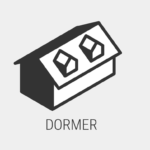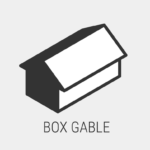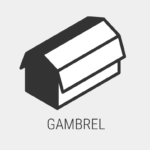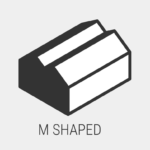Roofing Basics: 18 Most Popular Types of Roofs
If you’re looking to redo your entire home or even build one from scratch, knowing the types of roofs and the benefits of each is one of the first and most important steps.
Below, we’ve compiled a list of 18 amazing roof types that range from a basic gable roof all the way to a sawtooth design–so no matter what look you’re going for, you can find inspiration here.
A-Frame
The a-frame is an inexpensive roof design, as it is both the roof and the walls of the home. The roof extends all the way to the ground, making a steep triangular or “A” shape. These roofs are great for a small, modern-style home with a simplistic and unique design.
Butterfly
No matter if the sides of the roof are symmetrical or asymmetrical, the butterfly roof looks as though it is in mid-flight. The benefit of having this design is your home can have tall ceilings on both sides of the house. One thing to keep in mind with a butterfly design is to make sure that the valley has proficient water-proofing layers or your roof may leak and eventually collapse.
Clerestory
Usually found in smaller homes, the clerestory roof features an interior roof extending from one part of the roof. This wall is made entirely of windows, whether multiple small windows or one connecting window. Its goal is to let a lot of natural light in without sacrificing privacy.
Dome
If you’re looking for a major change that looks almost like it jumped from a dystopia, the dome roof is the perfect fit. While it can be like the A frame—it may be both walls and roof—the dome can also just be the roof.
Dormer
Less of an actual roof type and more of a roof accessory, the dormer features a window projecting from the roof to add light to a loft or attic space that may be transformed into a living space. Nearly every roof type can feature dormer windows.
Sawtooth
As the name suggests, the sawtooth resembles a sawblade’s teeth with the roof being set up slope-wall-slope-wall design. Sawtooth roofs are often used in eco-friendly homes for their focus on natural light. Not to mention, they’re perfect to install solar panels on.
Flat
Flat roofs are actually not entirely flat and probably have the slightest angle to them to help with drainage, but they still appear flat enough to earn the name “flat roof.” Flat roofs are great for achieving the mid-century or modern look as they can stack and stack to create a geometrical angled display of a house. An additional benefit of flat roofs is that they can be easily transformed into green roofs.
Gable
Some of the most popular roofs, the gable roof is known for its triangular shape and for its ease of installation. There are many different types of gable roofs—box, open, hipped, cross, dutch—but they all share the common characteristic of a triangular design.
Gambrel
Also known as the “barn roof,” gambrel roofs have two different slopes with the lower side being extremely steep and the upper side is a lot less steep. Having the extremely high slopes gives way for more living space in the loft area, but it does make the roof harder to take care of in areas with high winds.
Curved
These roofs are found on more contemporary homes because we only recently have roofing materials that allow for a curve. One of the best things about curved roofs are they are highly customizable, making them fit your climate (and aesthetic) needs best.
Jerkinhead
Closely related to the gable roof, the jerkinhead is designed to withstand winds better than the gable roof as it has excess roofing on the gable clipped off. Jerkinheads and dormers make a great combination; views from the dormer windows are not obstructed thanks to the clipped corners.
Hip
The hip roof, like the gable roof, has many variations that make it highly customizable. A hip roof has slopes on all four sides, which may or may not lead to a pointed top. It is extremely durable and versatile.
Mansard
Otherwise known as the “French roof,” mansard roofs are basically a combination of hip and gambrel. They have four slopes coming together in hip fashion, but the slopes of the gambrel. If you’re really looking to add extra living space within your roof, mansards are the way to go.
M-Shaped
The M-shaped roof is essential, at its very core, a double pitched gable roof. The roof is supported by two load-bearing walls in order to create the desired M-shape with the deep valley. M-shaped roofs must be properly maintained in order to decrease the likelihood of water damage.
Parapet
A unique take on the flat roof, parapet roofs have the walls of the home extending up past the roof to create a boxed in roof that is perfect for gardens or outdoor living spaces on top of the roof. Many western saloons and castle towers feature the parapet roof.
Saltbox
The saltbox is probably the least popular of the roofs we have listed, but you shouldn’t count it out just yet. The goal of a saltbox roof is to create a perfect environment for high, vaulted ceilings.
Shed
Shed, sloped, or skillion, the basic design is the same; a flat roof with a steep surface. Skillion roofs are made of one continuous sheet of material which makes them a favorite to installers. Truly, they are perfect for snow and rain runoff and if you want a high functioning roof with a bit of pizzazz, then the sloped roof is for you.
Combination
As you’ve no doubt gathered, combinations of these roofs are more common than having just the basic form of the roof. Take what you like, both the practical aspects and the aesthetic sides and combine them to create your very own one-of-a-kind roof.
References
https://www.roofcostestimator.com/top-15-roof-types-and-their-pros-cons/#sawtooth%20roof
https://www.roofingcalc.com/top-20-roof-types/
https://homeydecor.co/category/roofing/
https://www.homestratosphere.com/home-roof-designs/











